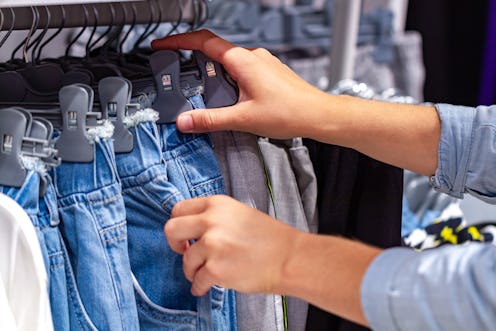Fashion
This Is What Really Needs To Change To Make The Fast Fashion Industry Sustainable

In recent years, the number of high street retailers introducing so-called "conscious" collections has soared. So when yet another clothing company announces sustainable plans, it seems only appropriate to react with a round of applause. Yet fast fashion culture persists. And what that means is that fashion brands' current sustainable plans may not make much of an impact.
Most recently, Zara came under the spotlight. Inditex, the brand's parent company, pledged that all Zara clothes would be made from 100 percent sustainable fabrics by the year 2025, per the Guardian. Similarly, reports Retail Gazette, H&M has promised to ensure that all of its materials and products will be recycled or sustainably sourced by 2030.
Unfortunately, as they stand, these plans seem more like lip service than the serious shake up the industry needs. While high street brands may have the right intentions, their business models are, quite frankly, all wrong. According to the Business of Fashion, Zara releases around 500 new items every week. That churn — which doesn't look likely to change any time soon — is contributing to the 300,000 tonnes of clothing being chucked in the bin each year in the UK. Around 20 percent of this ends up in landfill with the remaining 80 percent incinerated, reports the Environmental Audit Committee.
Arguably, it's not the way clothes are made that will make the industry green, but the willingness to change production numbers and seal an eco-friendly fate for garments.
Jo Salter, founder of ethical fashion brand Where Does It Come From? says "it’s great to see" big high street names "getting involved in sustainability and setting goals. This reflects their recognition that customers are growing more environment and trade justice aware."
But, to be truly sustainable, companies will "have to be totally transparent and help drive shopping culture change," she adds. "Yes, clothing has to be sustainable and ethically produced, but it also has to be high quality, versatile, long-lasting, and priced accordingly so that customers will ditch the throwaway habits and value and respect the clothing they buy."
A 2016 McKinsey report estimated that making just one kilogram of fabric produces 23 kilograms of greenhouse gases. It also noted that current recycling technologies "work poorly," resulting in three fifths of clothing being burnt or left to rot.
Committing to less impactful production methods will help, but only to a degree, as Vogue notes, as many retailers don't own the factories responsible. Using brand clout to put pressure on these factories will, again, help, but harder hitting strategies need to be enforced.
It could be up to consumers to force the change. But the government must also do much more. It recently rejected every sustainable fashion recommendation offered by a group of MPs, including introducing a one penny clothing charge on items to encourage sustainability, mandatory environmental targets for major retailers, and a ban on burning or landfilling unsold designs. This doesn't reflect the public's changing attitude towards fast fashion.
Retail and consumer expert Martin Newman explains, "Consumer attitudes towards fast fashion and fast fashion retailers may well change, particularly as they become increasingly aware of their own carbon footprint and given the importance millennials and generation alpha place on the environment and sustainability."
And new research from marketing company inRiver demonstrates the level of care young consumers have for the planet. In a survey of 1,500 UK consumers between the ages of 16 and 44, 62 percent said they would stop using a brand if it was detrimental to the environment. Almost half said they'd be willing to pay more for upcycled or recycled products, while almost two thirds would reconsider their purchasing decisions if brands better communicated their environmental impact.
A "100 percent sustainable fabric" tagline sounds great, and Zara's commitment in particular "will make a huge difference," according to Newman, despite taking several years to implement. But, he adds, "there's a lot more to be done."
"High street fashion retailers need to find manufacturers who have a focus on sustainability throughout the whole supply chain process, work hard to only use recycled packaging, try to work with couriers who use or will be using electric bikes and electric vehicles, and, of course, try to also source locally to reduce the carbon footprint."
McKinsey, too, gave a list of recommendations to any fashion brand looking to change: Create products that are designed to be reused or recycled, encourage shoppers to use low-impact strategies, and support the development of new fibres and new recycling methods.
I believe there's one more to add to the list: Don't forget to produce less.